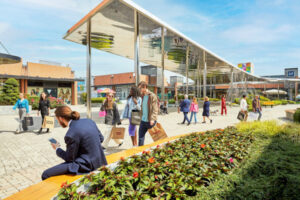By Gontran Thüring
This year, France is celebrating the 50th anniversary of its shopping centers. It was, indeed, in 1969 that Parly 2, in the greater Paris area, and Cap 3000, on the Riviera, opened their doors to the public. It was a true revolution for both retailers and customers at that time.
Their developers were completely inspired by the American model, which had been created approximately 10 years earlier: an enclosed mall with no natural light, anchored by department stores, and surrounded by oceans of surface parking lots.
How is the French shopping industry doing 50 years later? The French density of shopping centers is close to the European average, i.e., 0.27 sq m per inhabitant. Even though the French population is still growing, it is clear that the country is now well covered. New projects that are executed from scratch are the exception. The market is more oriented toward the renovation, restructuring, and renovation of existing schemes. Moreover, a new law that has recently been adopted will make it even more difficult to obtain planning permission for new projects and will make it possible for local public authorities to put a hold on them for a period of up to four years.
As a result, for both economic and political reasons, major trends in the upcoming years will include the following:
First: a dual market with, on the one hand, small convenient centers that are easily accessible by car via the countryside or by public transportation via metropolitan areas, and on the other hand, big and destination shopping/leisure malls with extensive catchment areas, most of them serving as extensions of existing ones.
Second: the end of the purely retail spot in favor of mixed-use, millennial-friendly projects that integrate physically and functionally different products and services, such as retail, naturally, as well as F&B, leisure, medical centers, co-working and co-living spaces, etc.
Third: the emergence of a new, truly phygital hybrid species that simultaneously serves as a sales platform as well as a showroom, a meeting point for specific communities, and a delivery point. All of this will be facilitated by the emergence of new technologies. For instance, and in a non-science fiction manner, these new centers will also likely function as manufacturing spots given the rapid progression of 3D printing devices.

Old shopping centers that were introduced in the sixties will become “third places”, as described by Ray Oldenburg. Places of community life and interaction, a “home away from home”, as he quoted himself.
As a result, the CNCC’s (French Council of Shopping Centers) name will soon be changed, as was done in the UK two years ago, to reflect this evolution and to adapt to a new paradigm that both tenants and consumers have already begun to take over.





